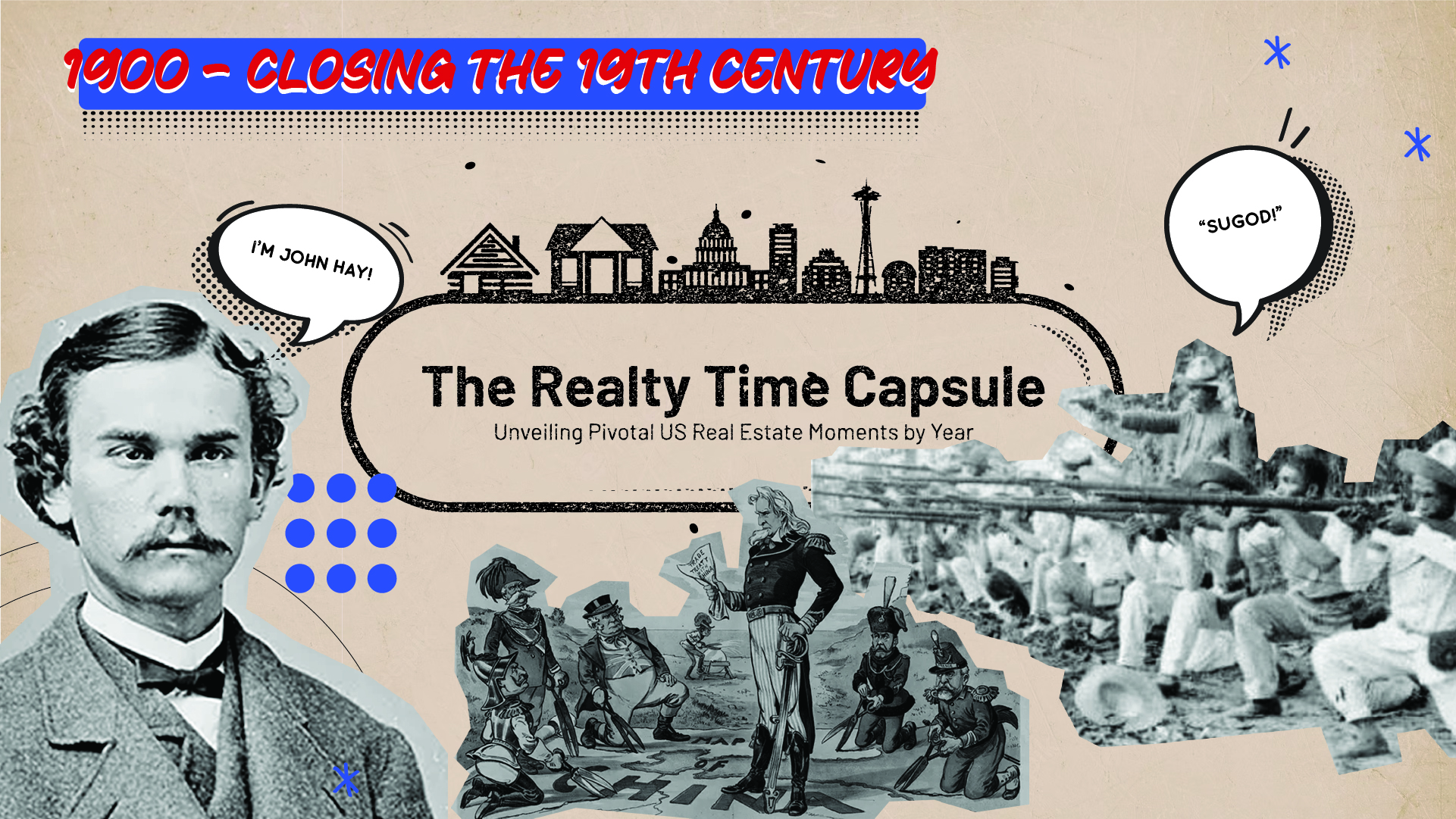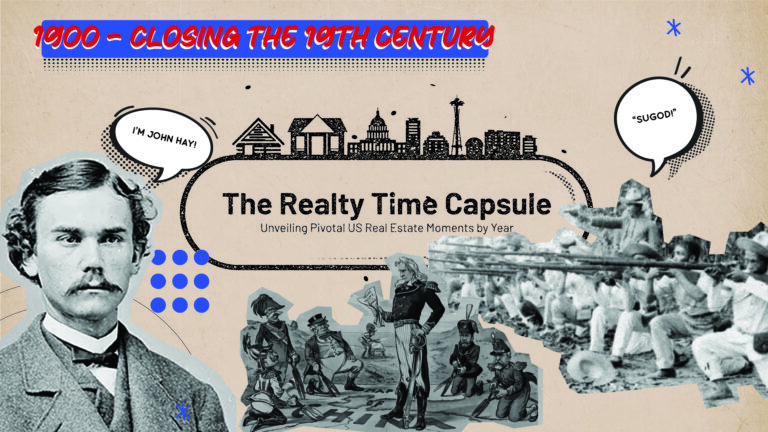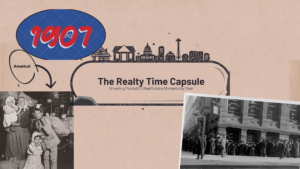
Introduction
The 19th century ushered in so many changes, not just in the United States but in the rest of the world as well. We now come to the end of that period. This Realty Time Capsule will look at the year 1900 and prepare as we usher in a new era.
Three Key Points
1. Open Door Policy: The 1900 Open Door Policy, articulated by U.S. Secretary of State John Hay, was a significant diplomatic initiative aimed at promoting equal commercial opportunities and maintaining the territorial integrity of China amidst the increasing encroachment by colonial powers. This policy was primarily directed at ensuring that all foreign nations could trade freely and equally in China, preventing any single power from monopolizing Chinese markets and resources.
The impact of the Open Door Policy on the American economy was multifaceted. Firstly, it ensured that American businesses had access to the vast Chinese market, which was crucial for the expansion of U.S. exports. By advocating for an open and competitive environment, the policy facilitated the growth of American trade in Asia, contributing to the economic boom in the early 20th century. U.S. companies benefited from the ability to sell goods such as textiles, steel, and machinery to a large and untapped consumer base.
Secondly, the policy reinforced the United States’ role as a global economic power. By positioning itself as a proponent of free trade, America garnered diplomatic leverage and enhanced its influence in international affairs. This not only promoted economic interests but also aligned with broader strategic goals, such as preventing rival powers from gaining undue influence in Asia.
Although its effect on China has been questioned, the 1900 Open Door Policy significantly boosted American economic interests by ensuring market access in China and reinforcing the United States’ position in global trade dynamics.
2. The Galveston Hurricane: The Galveston Hurricane of 1900, the deadliest natural disaster in U.S. history, struck the Texas coast on September 8, resulting in an estimated 6,000 to 12,000 deaths. The hurricane had profound impacts on American real estate and the broader economy.
The immediate aftermath saw widespread destruction of Galveston’s infrastructure and real estate. Approximately 3,600 buildings were destroyed, including homes, businesses, and public structures. The catastrophic damage disrupted the local economy, which was heavily reliant on its status as a thriving port city. Property values plummeted, and many investors faced significant financial losses. The hurricane’s devastation also led to a massive population exodus, further depressing the real estate market.
Economically, the hurricane’s impact extended beyond Galveston. The city had been a major commercial hub, and its destruction disrupted trade and shipping routes, affecting the regional economy. Businesses dependent on Galveston’s port were forced to reroute to other ports like Houston, which, in turn, saw a rapid increase in development and investment. This shift marked the decline of Galveston as a commercial powerhouse and the rise of Houston as a major economic center.
In response to the disaster, significant investments were made in Galveston’s infrastructure, including the construction of a seawall and raising the city’s elevation to prevent future flooding. These efforts, while costly, were crucial in rebuilding the city and restoring some level of economic stability.
Overall, the Galveston Hurricane reshaped the American real estate landscape, catalyzing the decline of one major port city and the rise of another, while prompting advances in disaster preparedness and urban planning.
3. Philippine–American War: The Philippine–American War, fought between 1899 and 1902, was a significant conflict following the Spanish-American War, where the United States aimed to suppress Filipino resistance to American rule. This war had substantial implications for the American economy and real estate sectors.
Economically, the war was costly for the United States, with expenditures estimated at around $400 million. This financial burden strained the national budget and redirected funds from domestic investments to military operations and colonial administration. Despite these costs, the war facilitated the expansion of American businesses into the Philippines. American companies capitalized on new opportunities in agricultural exports, particularly sugar, tobacco, and hemp, integrating the islands’ economy with the U.S. market and boosting American trade in the Asia-Pacific region.
In terms of real estate, the war and subsequent American colonization influenced the development of infrastructure in the Philippines. American investments led to the construction of roads, bridges, schools, and hospitals, which, while primarily benefiting the local economy, also provided lucrative contracts for American firms. This infrastructure development laid the groundwork for modernizing the Philippines, indirectly enhancing the value of related American businesses and real estate investments.
Additionally, the war and subsequent control over the Philippines underscored the United States’ emergence as a colonial power, reinforcing its influence in the Pacific. This strategic foothold bolstered America’s military and economic presence in Asia, further promoting international trade routes and economic expansion.
In summary, the Philippine–American War, despite its immediate financial costs, spurred long-term economic integration and infrastructure development, benefiting American business interests and solidifying the U.S.’s strategic and economic presence in the Asia-Pacific region.
Headline Real Estate News Stories In 1900
William McKinley was reelected as President of the United States in 1900, defeating Democratic challenger William Jennings Bryan. McKinley’s victory was largely attributed to the country’s economic prosperity and his successful leadership during the Spanish-American War. His campaign emphasized continued economic growth, industry support, and the gold standard, resonating with a nation experiencing robust economic expansion. McKinley’s reelection reaffirmed the Republican Party’s dominance and solidified America’s commitment to imperialism, as evidenced by ongoing efforts in the Philippines and new territories.
What Historic Real Estate Events Shaped 1900
The Spanish-American War which took place in 1898 would trigger the longer and bloodier conflict in the Philippines. While the war with the Spanish Empire would only last for less than a year, the American conquest and subjugation of the Philippines would last for several years and result in hundreds of thousands of civilian deaths.
Economic Factors, Supply, and Demand
The Gold Standard Act, enacted on March 14, 1900, under President William McKinley’s administration, officially placed the United States on the gold standard, defining the dollar’s value solely in terms of gold. This legislation marked a pivotal moment in American economic history, reinforcing gold as the sole basis for redeeming paper currency.
The Gold Standard Act had profound impacts on the American economy and real estate sector. Solidifying the gold standard, provided greater monetary stability and predictability, which was crucial for economic confidence. Investors, both domestic and international, viewed the U.S. as a financially stable and reliable place to invest, leading to increased foreign investment. This influx of capital stimulated various sectors of the economy, including real estate.
In the real estate market, the gold standard ensured that long-term contracts and loans had a stable value, reducing the risk of inflation. This stability encouraged both lenders and borrowers, fostering growth in the housing and commercial property markets. Predictable interest rates under the gold standard allowed for more secure financing options, promoting construction and real estate development.
Economically, the Gold Standard Act helped curb inflation and provided a sound currency, which was particularly beneficial for trade. U.S. exports became more attractive to foreign buyers who trusted the stability of the dollar, thus boosting American industries and agriculture. However, the gold standard also had its drawbacks. It limited the flexibility of monetary policy, making it difficult to respond to economic crises. This rigidity would later be a factor during the Great Depression.
American industries were also starting to gain dominance in 1900. For example, the Carnegie Steel Company has one-third of the world’s total steel supply. That output was about to increase even further.
Government Policies and Interventions
In 1900, President William McKinley placed Alaska under military rule primarily to address lawlessness and administrative challenges in the region. Following its purchase from Russia in 1867, Alaska saw a significant influx of settlers, particularly due to gold rushes such as the Klondike Gold Rush. This rapid population increase led to widespread disorder, with inadequate local governance and law enforcement to manage the growing and often unruly population.
Military rule was seen as a necessary measure to restore and maintain order, protect the rights of the native population, and ensure the safety of settlers and the proper functioning of economic activities. The presence of the military helped establish a semblance of law and authority, which was crucial for the stability and development of the territory. Additionally, the military administration facilitated the implementation of federal laws and the protection of U.S. interests in the region during a period when Alaska’s infrastructure and civil institutions were still underdeveloped.
By imposing military rule, McKinley’s administration aimed to create a more controlled and orderly environment, laying the groundwork for future civil governance and the integration of Alaska into the broader framework of American territory management. This period of military governance was a transitional phase that ultimately contributed to the region’s long-term stability and development.
It was also the year that Hawaii was granted self-governance with the passing of the Organic Act, which officially made Hawaii a U.S. territory. It also gave Hawaiians American citizenship.
Demographic Factors
The 1900 Census of the United States provided comprehensive data on the American population at the turn of the century. It recorded a total population of 76.2 million (about twice the population of California), reflecting significant growth due to immigration and natural increases. This census was notable for introducing the use of punch cards and mechanical tabulation, improving data processing efficiency. It collected detailed information on demographics, including age, gender, race, occupation, and home ownership, offering valuable insights into social and economic trends. The data from the 1900 Census helped guide policy decisions and urban planning during a period of rapid industrialization and urbanization.
Societal Preferences and Trends
In 1900, the temperance movement, advocating for the reduction or prohibition of alcohol consumption, gained significant momentum in the United States. Spearheaded by organizations like the Woman’s Christian Temperance Union (WCTU) and the Anti-Saloon League, the movement aimed to address social issues linked to alcohol, influencing public policy and leading to Prohibition in 1920.
Technological Innovations
In 1900, New York City introduced the first electric bus, marking a revolutionary step in urban transportation. This innovation, powered by electricity rather than fossil fuels, offered a cleaner and quieter alternative to traditional horse-drawn and steam-powered vehicles, paving the way for modern public transit systems.
Cultural Factors
In terms of food, the year 1900 was significant because it was then that Milton S. Hershey introduced the milk chocolate Hershey bar, which would become an American icon. It was also in the same year in New Haven, Connecticut, that Louis Lassen of Louis’ Lunch made the first modern-day hamburger, arguably, the food that is most identified with America.
Transportaion and Infrastructure
In 1900, New York City Mayor Robert Anderson Van Wyck initiated the groundbreaking for a groundbreaking project: the construction of the city’s first underground “Rapid Transit Railroad,” connecting Manhattan and Brooklyn. This ambitious undertaking symbolized a leap forward in urban infrastructure, addressing the growing need for efficient transportation amidst the city’s burgeoning population and expanding metropolitan area. The subway system, when completed, not only facilitated daily commutes but also fueled the city’s economic growth by improving accessibility and connectivity.
Simultaneously, the opening of the first automobile show in the United States at New York City’s Madison Square Garden reflected the dawn of a new era in transportation. The showcase of automobiles, ranging from the innovative to the luxurious, captured the imagination of the public and underscored the burgeoning fascination with motor vehicles. This event signaled the beginning of the automotive revolution, heralding profound changes in American society, from mobility and leisure to industry and culture.
Closing This Capsule
This Realty Time Capsule closes the 19th century. For our next article, we will be looking into the world of the 20th century, which is even more filled with changes and developments.
For a deeper understanding and look into these topics check out these titles:
The Philippine-American War:
-
“A War of Frontier and Empire: The Philippine-American War 1899-1902“, by David J. Silbey
-
The Philippine War, 1899-1902 (Modern War Studies) Paperback by Brian McAllister Linn
The Galveston Hurricane:
-
“Story of the 1900 Galveston Hurricane (HURRICANE SERIES)“, by Isaac Cline






